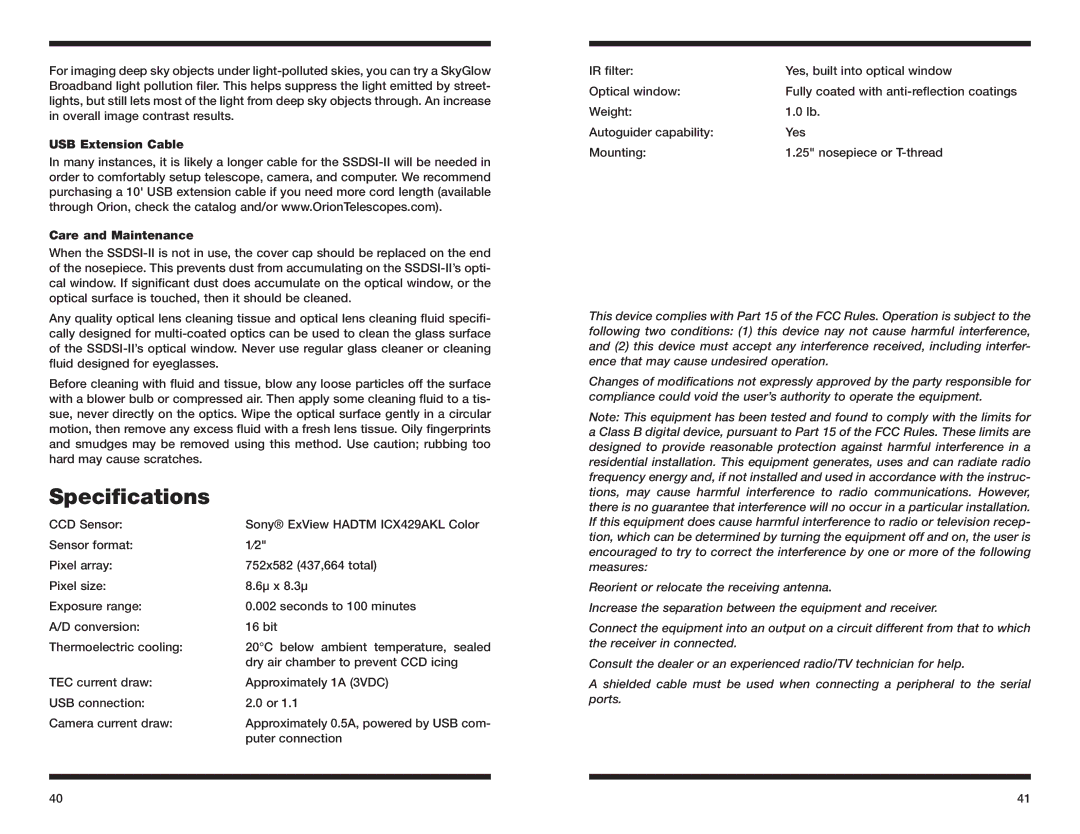
For imaging deep sky objects under
USB Extension Cable
In many instances, it is likely a longer cable for the
Care and Maintenance
When the
Any quality optical lens cleaning tissue and optical lens cleaning fluid specifi- cally designed for
Before cleaning with fluid and tissue, blow any loose particles off the surface with a blower bulb or compressed air. Then apply some cleaning fluid to a tis- sue, never directly on the optics. Wipe the optical surface gently in a circular motion, then remove any excess fluid with a fresh lens tissue. Oily fingerprints and smudges may be removed using this method. Use caution; rubbing too hard may cause scratches.
Specifications
CCD Sensor: | Sony® ExView HADTM ICX429AKL Color |
Sensor format: | 1⁄2" |
Pixel array: | 752x582 (437,664 total) |
Pixel size: | 8.6µ x 8.3µ |
Exposure range: | 0.002 seconds to 100 minutes |
A/D conversion: | 16 bit |
Thermoelectric cooling: | 20°C below ambient temperature, sealed |
| dry air chamber to prevent CCD icing |
TEC current draw: | Approximately 1A (3VDC) |
USB connection: | 2.0 or 1.1 |
Camera current draw: | Approximately 0.5A, powered by USB com- |
| puter connection |
IR filter: | Yes, built into optical window |
Optical window: | Fully coated with |
Weight: | 1.0 lb. |
Autoguider capability: | Yes |
Mounting: | 1.25" nosepiece or |
This device complies with Part 15 of the FCC Rules. Operation is subject to the following two conditions: (1) this device nay not cause harmful interference, and (2) this device must accept any interference received, including interfer- ence that may cause undesired operation.
Changes of modifications not expressly approved by the party responsible for compliance could void the user’s authority to operate the equipment.
Note: This equipment has been tested and found to comply with the limits for a Class B digital device, pursuant to Part 15 of the FCC Rules. These limits are designed to provide reasonable protection against harmful interference in a residential installation. This equipment generates, uses and can radiate radio frequency energy and, if not installed and used in accordance with the instruc- tions, may cause harmful interference to radio communications. However, there is no guarantee that interference will no occur in a particular installation. If this equipment does cause harmful interference to radio or television recep- tion, which can be determined by turning the equipment off and on, the user is encouraged to try to correct the interference by one or more of the following measures:
Reorient or relocate the receiving antenna.
Increase the separation between the equipment and receiver.
Connect the equipment into an output on a circuit different from that to which the receiver in connected.
Consult the dealer or an experienced radio/TV technician for help.
A shielded cable must be used when connecting a peripheral to the serial ports.
40 | 41 |
